In a world… where Chuck E. Cheese tokens are legal tender
typed for your pleasure on 9 April 2016, at 1.42 amSdtrk: ‘Date night’ by Will Yates
My satisfactory job excels in many ways — I often will tell anyone within earshot that it’s the best job I’ve ever had. The only downsides are that
1) the drive to and from work is lengthy (roughly 25min there and about an hour back, under normal circumstances), and
2) it doesn’t involve me closely inspecting Synthetik girlfeet for eight hours a day. But then, if we had everything we wanted, we’d be spoiled. I say that a lot, too.
However, to take my mind off the first issue, I’ve begun revisiting the distracting wonder that is the podcast. I’m not going to list my favourites here, as I intend on covering that in a future post, but I’m more than halfway through a series entitled ‘Germany: Memories of a nation‘, available from BBC Radio 4. Over the course of thirty episodes, host Neil MacGregor discusses various points concerning Deutschland’s geographical and social history, which is actually more fascinating than it sounds. True, some episodes are a bit boring (‘The Battle for Charlemagne’, for example), but others are really fascinating, like the one detailing the Bauhaus school of design, which I’ve always been intrigued with, and the one focussing on Notgeld. Now I want to buy some godforsaken Notgeld, cos obviously I need more ephemera in my life and to add to my rapidly-filling flat.
‘What’s Notgeld?? What the hell is it??’ you shriek, eyes wide, mouth frothing at the corners. Ah, I can sense that you are intrigued! First, a high-speed primer as to the situations which caused Notgeld to come into existence.
During World War I, Germany’s economy was sliding rapidly down the toilet, as the cost of the war effort was bringing about inflation. It kicked into high gear in 1922, where things were so bad that the Deutsche Mark would lose value over the course of a week. You’d have people getting their paycheques, and immediately racing to the shops to spend them before they were near-worthless. When this happened, which was often, the banks would issue new notes of higher value. Eventually it got so that the more notes there were in circulation, the less they were worth — which is where you get those anecdotes in history books of citizens literally bringing in wheelbarrows filled with Marks into shops, just to purchase groceries — and at any rate, the banks couldn’t afford to keep printing them.
The solution, then, was Notgeld, which is German for ‘necessity money’. It was defined as the currency that institutions would issue during economic or political crises, mainly when the national bank was out of regular money. These were issued not only by the national banks, but also by the banking institutions of various towns and municipalities. Of course, since metal was in short supply due to there being some sort of ‘world’ ‘war’ taking place, a lot of the denominations were printed on paper. Even then, issuers would get fancy, due to lack of overall materials, and would design notes made from silk, or leather, or postage stamps, or porcelain, or my favourite, compressed coaldust.
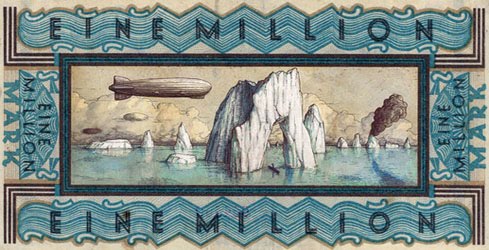
Zeppelins and icebergs, always awesome
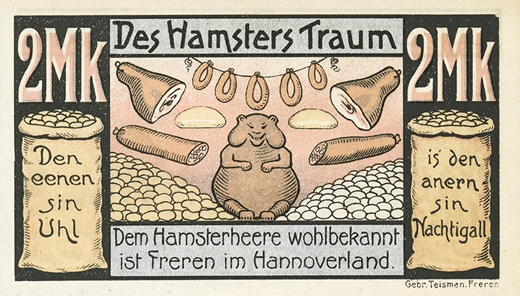
‘The Hamster’s Dream’. Anything with a hamster on it is automatically great. Although he looks a bit sinister
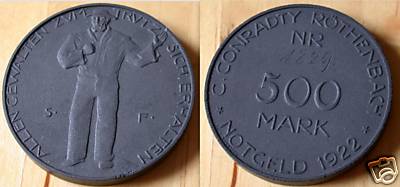
This is one of the coal coins. I can’t imagine them doing a person’s pockets any favours. Because of the dust, not because you have money, you see. Quit your bitching, at least you have money. And stop licking your fingers
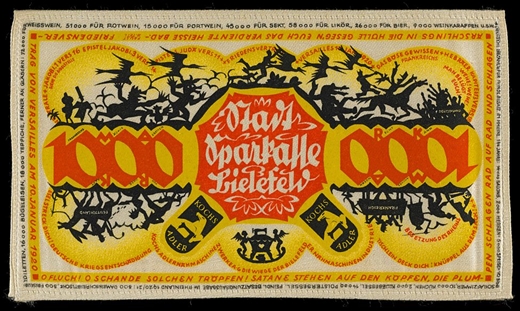
A Notgeld made of linen. Like a tea towel, that… you can use… to buy actual tea towels with
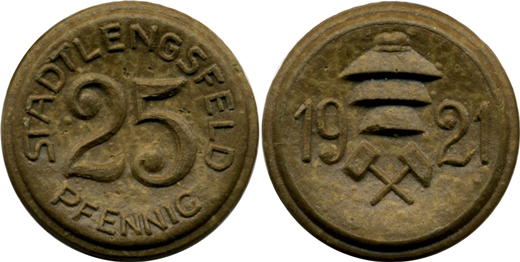
Porcelain coinage
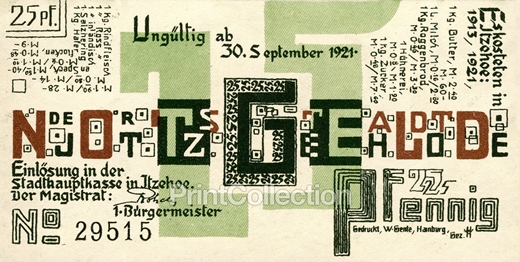
This one, designed by Wenzel Hablik, really speaks to me. Not only does it have a very cool, Ray-Gun-magazine-filtered-through-Bauhaus look to it, it’s a document of the economic situation that created it. Part of the text lists how much average things were in Itzehoe, the town it was issued in, in 1921
Vertical Text in top right corner: “It costs in Itzeohe in 1913 / 1921 1 Kilo Butter: 2.40 Marks/60 Marks 1 Liter Milk: 16 Pfennigs/2.80 Marks 1 Kilo rye bread: 46 Pfennings/3.30 Marks 1 egg: 8 Pfennigs/1.90 Marks 1 Kilo sugar: 48 Pfennigs/ 7.60 Marks”
Text in top left corner: “1 Kilo beef: 1.90 Marks/28 Marks 1 Kilo horsemeat: 80 Pfennigs/14 Marks 1 Kilo domestic bacon: 1.5 Marks/40 Marks 1 Herring: 6 Pfennigs/1.40 Marks 1 Kilo oatmeal: 48 Pfennigs/9 Marks”
Not only were they in demand cos they were, y’know, legal tender, but the uniqueness of the designs encouraged interest and use. Many towns depicted scenes on the notes or coins related to their history, or associated with their industry.
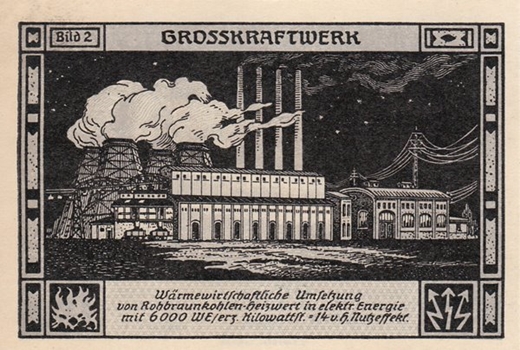
Such as this one from Bitterfeld, showcasing a power plant…
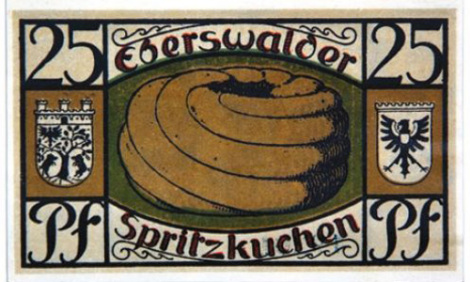
…or this one from the town of Eberswalde, known for its delicious all-pastry tyres.
Admittedly, my super-rudimentary knowledge of German had me initially thinking Notgeld meant ‘Not money’, but unsurprisingly, I was wrong.
You’ll be pleased to know that if you really want to own examples of Notgeld, eBay has a shedload of reasonably-priced ones on offer. I mean, I’m doing my damnedest not to buy this set, as its German Expressionist design speaks to me. I’ll note that the paper ones are easiest/cheapest to find — if you’re going to aim for hardcore status and attempt to purchase some of those compressed coal ones, you’ll find that examples of those are quite rare, as a good number of those were used as fuel. Still, there are worse hobbies! You can’t make your own Notgeld to buy the vintage Notgeld with, however; it doesn’t work like that
Random similar posts, for more timewasting:
Transform and... double-park on May 31st, 2007
The Eighties are back! And THEY'RE COMING FOR YOUR EARS on February 6th, 2010










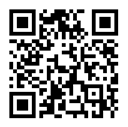

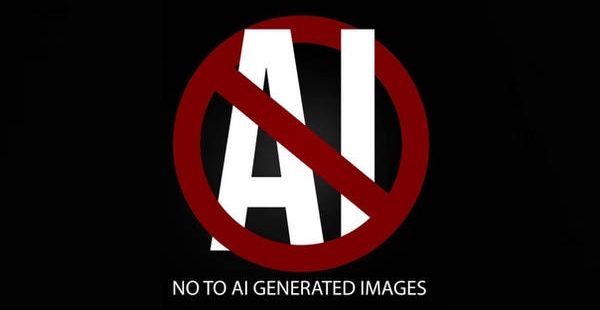

April 9th, 2016 at 3.47 am
Hai Dave to the Cat, ignore my silly introduction there, lol, ur new interest aka hobby reminds me one of novel written by Nicholas Spark, the notebook that one of main character really love to collect things like that, not try to mention that u look like main character in that novel just made my mind reminds one of chapter The Notebook.Um,am i talking rubbish just now.oh ya fine got it,haha.btw keep it up davecat.
April 9th, 2016 at 3.55 am
Sorry,correction,dear john by nicholas spark not the notebook,
April 9th, 2016 at 9.30 am
Very interesting. It seems that hard times are often a boon to artistic creativity. Genre like the blues thrive on it. Good times seem to foster narcissistic, self indulgent works that just don’t stand the test of time.
Unfortunately I think we’re in for creative times ahead . . .
April 9th, 2016 at 7.23 pm
Nana —
Well, ‘new hobby’ is pushing it a bit. I have to complete some of my old hobbies before starting a new one, y’know! If Deafening silence Plus wasn’t restricted to 600 sq.ft, and if I were making twice as much money as I am now, then our palatial home would be brim-filled with Notgeld. But it’s a goal!
I may have to look into this book by Nicholas Spark, however…
Yeronda —
You’re right, though. With the course of various instances of society, hardship has made creativity flourish… basically, I see it as a result of wanting some manner to escape the crush of reality. I mean, look at Punk, which was a direct result of Thatcher’s bullshit parade of a career!
Hopefully the near-future maintains creative sparks, but doesn’t plunge us into a post-apocalypse. Although it could be said that the world of Mad Max completely embraces creativity, for better or for worse!…
And we need to get you a proper Gravatar, sir! Perhaps your Nataliya will let you use one of her photos? Ask nicely. 🙂
April 15th, 2016 at 4.34 pm
I have never been to Germany, but they are clearly an interesting bunch. Among my old mum’s books is a slim one of exquisite silhoutte drawings of the life of a family by Rudolf Koch, the calligrapher. (My mum had a degree in German, for some reason.) I would quote its title, but the typeface is incomprehensible. (Just decyphering the author’s name was a challenge.) So, I am about to embark on listening to that Radio 4 series…
April 17th, 2016 at 8.22 pm
Germans are awesome! I like their aesthetic! Any country that can conjure up ideas such as the Bauhaus school or the Weimar era in general gets full Marks from me! (That’s a money pun, by the way. Full ‘Marks’? Geddit?? These are the jokes, folks)
I will agree that old German script is incredibly dense. It makes me wonder how long it took for those familiar with the language to be able to understand it, as the letters are so blocky and very similar. I’m thinking there was a lot of bluffing being done back then. I mean, what the living hell is this supposed to say??